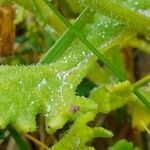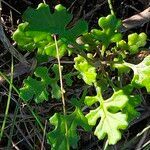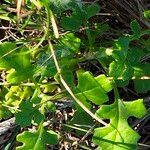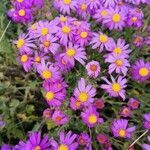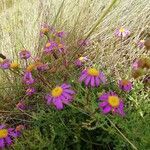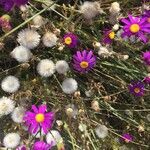Erect or sprawling annual, to 1.0 m high, nearly glabrous. Leaves to 20 cm long, with l:w ratio c. 2–4, subpinnatisect with 2–5 major segments per side; segments typically broadest distally and irregularly lobed; base slightly to moderately auriculate, slightly clasping. Capitula few to numerous per stem; calycular bracteoles 12–16, 3–5 mm long, c. 1.5–2 mm wide; involucre 7–8 mm long, c. 5–7 mm diam.; bracts 12–16, glabrous. Florets numerous; ligulate florets usually 12–17; ligule 7–15 mm long, 4-veined, rich magenta, occasionally pink or white. Achenes narrowly obloid, 2.5–3.2 mm long, brown or olive, with papillose hairs forming lines. Pappus caducous, 5–7 mm long. Source: Thompson (2015: 303). See also Belcher (1994: 392).
Annual herb, glandular-hairy. Stems erect or decumbent, up to 1 m high, much branched. Leaves ± fleshy, sessile, auriculate basally, oblong in outline, up to 80 mm long, pinnatifid to bipinnatipartite, margins revolute. Inflorescence laxly corymbose, several headed. Capitula radiate, disc yellow, rays pale mauve to purple, rarely absent(?); involucre broadly campanulate; bracts 12-15, 8-9 mm long, black-tipped, calyculus bracts many, ciliate, black-tipped. Flowering time mainly Sept.-Dec. Cypselae cylindrical, 3.0-3.5 mm long, ribbed, hairy.
Densely glandular-hairy annual to 1 m. Leaves fleshy, incised to pinnatisect, margins revolute. Flower heads radiate, numerous in dense corymbs, yellow with purple rays, involucre conspicuously calycled.
Stem diffuse, thick and rigid, roughly pubescent; leaves more frequently lyrate, with a large terminal lobe; inv. scales piloso-scabrous.
A herb.
